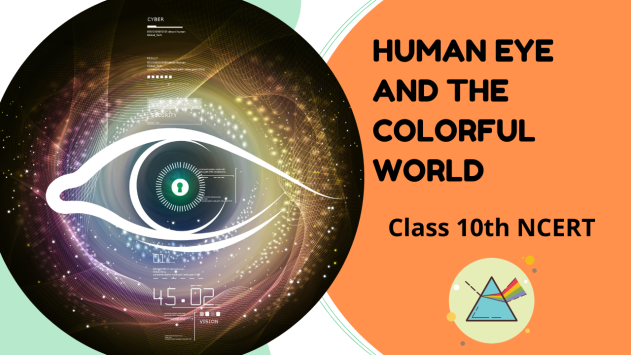We have shared the class 10th Human Eye and the colorful world Class 10th Physics chapter to strengthen the board-appearing students’ concepts and make their physics accuracy as pristine as possible. We will also share the mind map of the Human Eye Class 10th to make the concepts on the tips.
We are also sharing NCERT Solutions for class 10th Physics Human Eye and the colorful world to help the board-appearing candidates with the ncert solutions to make them understand the chapter Human eye and the colorful world class 10th Science Ncert very clearly. In this chapter, we will also share various parts of the Human Eye, diseases of the Human Eye, etc.
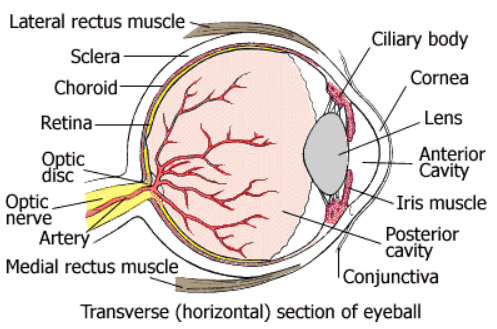
Human eye And The Colorful World Class 10th: Introduction
Vitamin A (raw carrots, broccoli, green vegetables, cod-liver oil, etc.) is necessary for good
vision.
To protect your eyes, the following points should be remembered:
1. Avoid reading in dim light.
2. Wash your eyes at least four times daily with clean and cold water.
3. Wash your eyes quickly if dust particles or small insects enter your eye.
4. Visit an eye specialist regularly. Improper vision can cause stress, eyestrain, and even
headaches.
5. While reading, maintain a distance of at least 25 cm between your eyes and the book.
6. Do not rub your eyes. If redness in the eye persists, then consult an eye specialist
immediately.
7. Avoid direct exposure to sunlight. Exposure to a large amount of light can harm your retina.
Power of accommodation
o Ability of the lens to adjust its focal length
o Thickness of the lens is controlled by ciliary muscles
o Nearest focal distance of lens = 25 cm
Defects
o Myopia/near-sightedness
Problem: Distant objects cannot be seen clearly
Image is formed in front of the retina
Correction –concave lens
Hypermetropia/far-sightedness
o Problem: Near objects are not seen clearly
o Image formed beyond the retina
o Correction – convex lens
Presbyopia – Near-focus distance increases with age
o Power of accommodation decreases
o Correction– Bi-focal lens and concave lens
Refraction through a prism
o Light bends because of refraction that takes place at points B and C.
o The extent of deviation of the light ray from its path BE to path CD is known as the angle of deviation ( )
The splitting of a beam of white light into its seven constituent colors when it passes
through a glass, prism is called the dispersion of light
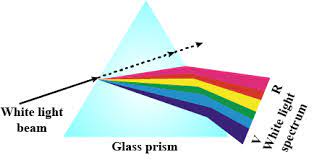
o Red → Disperses least
o Violet → Disperses most
o Yellow → Average of all lights
The formation of a rainbow is a natural phenomenon in which white sunlight splits into beautiful colors by water droplets.
The flickering of objects is because the air above the fire is relatively hotter than the air
further up in the atmosphere.
Twinkling of stars – caused by changing air density in the atmosphere
Early sunrise and delayed sunset – are caused by the refraction of light through the atmosphere
The sun and the planets do not twinkle because they are not seen as point sources like
stars but are considered as extended sources.
Scattering is the phenomenon of absorption and re-emission of light.
The phenomenon of scattering light by the colloidal particle gives rise to the Tyndall effect.
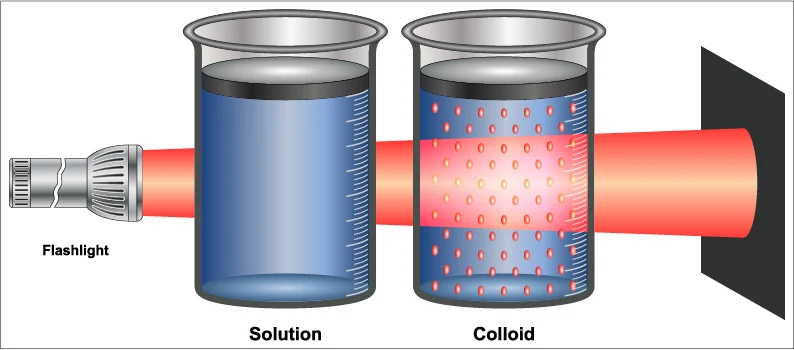
Atmospheric particles, smoke, tiny water droplets, suspended particles of dust, and air
molecules scatter sunlight. Therefore, the path of light becomes visible.
The sky is blue- because light near blue wavelength scatters most.
Danger signs are red- because red light scatters the least.
Human eye And The Colorful World Class 10th: Mind Map
We are sharing the mind map of the Human eye And The Colorful World Class 10th: Introduction to help the students of class 10th to grasp the topic at a glance and remember it till their board exams. Mind Maps are an easy way to get a hold of the topic; it is like a cake in the walk to remember the concepts.
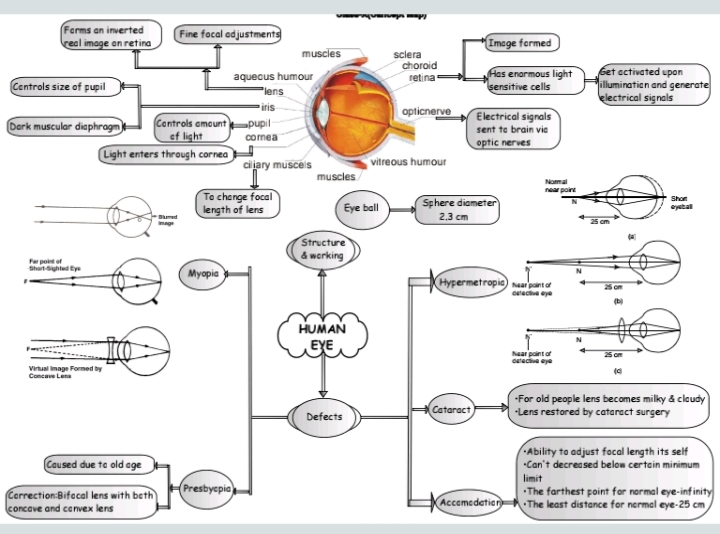
NCERT Solutions for class 10th Physics Human Eye and the colorful world
Question 1:
What is meant by the power of accommodation of the eye?
Answer 1:
When the ciliary muscles are relaxed, the eye lens becomes thin, the focal length
increases, and the distant objects are visible to the eyes. To see the nearby objects
clearly, the ciliary muscles contract making the eye lens thicker. Thus, the focal length of
the eye lens decreases, and the nearby objects become visible to the eyes. Hence, the
human eye lens can adjust its focal length to view distant and nearby objects
on the retina. This ability is called the power of accommodation of the eyes.
Question 2:
What is the human eye’s far and near point with normal vision?
Answer 2:
The eye’s near point is the minimum distance of the object from the eye, which can
be seen distinctly without strain. For a normal human eye, this distance is 25 cm. The eye’s far point is the maximum distance to which the eye can see the objects clearly.
The far point of the average human eye is infinity.
Question 3:
A student has difficulty reading the blackboard while sitting in the last row. What could be the defect the child is suffering from? How can it be corrected?
Answer 3:
A student has difficulty reading the blackboard while sitting in the last row. It shows
that he is unable to see distant objects. He is suffering from myopia. This defect
can be corrected by using a concave lens.
Question 4:
The human eye can focus objects at different distances by adjusting the focal length of the eye lens. This is due to
(a) presbyopia
(b) accommodation
(c) near-sightedness
(d) far-sightedness
Answer 4:
(b) Human eye can change the focal length of the eye lens to see the objects situated at
various distances from the eye. This is possible due to the power of accommodation of the
eye lens.
Question 5:
The human eye forms the image of an object at its
(a) cornea (b) iris (c) pupil (d) retina
Answer 5:
(d) The human eye forms the image of an object at its retina.
Question 6:
The least distance of distinct vision for a young adult with normal vision is about
(a) 25 m
(b) 2.5 cm
(c) 25 cm
(d) 2.5 m
Answer 6:
(c) The least distance of distinct vision is the minimum distance of an object to see a clear
and distinct image. It is 25 cm for a young adult with typical visions.
Question 4:
The change in focal length of an eye lens is caused by the action of the
(a) pupil
(b) retina
(c) ciliary muscles
(d) iris
Answer 4:
(c) The relaxation or contraction of ciliary muscles changes the curvature of the eye lens.
The curvature of the eye lens changes the focal length of the eyes. Hence, the
change in the focal length of an eye lens is caused by the action of ciliary muscles.
Question 5:
A person needs a lens of power −5.5 dioptres to correct his distant vision. He needs a lens of power +1.5 dioptre to correct his near vision. What is the focal length? of the lens required for correcting (i) distant vision and (ii) near vision?
Answer 5:
For distant vision = −0.181 m, for near vision = 0.667 m
The relation gives the power P of a lens of focal length f
(i) Power of the lens used for correcting distant vision = −5.5 D
The focal length of the required lens, f =1/P
The focal length of the lens for correcting distant vision is −0.181 m.
(ii) Power of the lens used for correcting near vision = +1.5 D
The focal length of the required lens, f =1/P
The focal length of the lens for correcting near vision is 0.667 m.
Question 6:
The far point of a myopic person is 80 cm in front of the eye. What is the nature and power of the lens required to correct the problem?
Answer 6:
The person is suffering from an eye defect called myopia. In this defect, the image is
formed in front of the retina. Hence, a concave lens is used to correct this defect of vision.
Object distance, u = infinity =
Image distance, v = −80 cm Focal
length = f
According to the lens formula,
We know,
A concave lens of power −1.25 D is required by the person to correct his defect.
Question 7:
Make a diagram to show how hypermetropia is corrected. The near point of a hypermetropic eye is 1 m. What is the power of the lens required to correct this defect? Assume that the near point of the normal eye is 25 cm.
Answer 7:
People suffering from hypermetropia can see distinct objects clearly but face difficulty
seeing nearby objects. The eye lens focuses the incoming
divergent rays beyond the retina. This defect of vision is corrected by using a convex lens.
A convex lens of suitable power converges the incoming light so that the image
is formed on the retina, as shown in the following figure.
Question 8:
What happens to the image distance in the eye when we increase the distance of an object from the eye?
Answer 8:
Since the size of the eyes cannot increase or decrease, the image distance remains constant. When we increase the distance of an object from the eye, the image distance in the eye does not change. The increase in the object distance is compensated by the change in the focal length of the eye lens. The focal length of the eyes changes in such a way that the image is always formed at the retina of the eye.
Question 9:
Why do stars twinkle?
Answer 9:
Stars emit their light and twinkle due to light’s atmospheric refraction. Stars
are very far away from the earth. Hence, they are considered as point sources of light.
When the light coming from stars enters the earth’s atmosphere, it gets refracted at
different levels because of the variation in the air density at different levels of the atmosphere. When the star light refracted by the atmosphere comes more towards us, it
appears brighter than when it comes less towards us. Therefore, it appears as if the stars
are twinkling at night.
Question 10:
Explain why the planets do not twinkle.
Answer 10:
Planets do not twinkle because they appear more significant than the stars as they are
closer to earth. Planets can be considered as a collection of a large number of
point-size sources of light. The different parts of these planets produce either brighter or
dimmer effects so that the average of brighter and dimmer effects is zero.
Hence, the twinkling effects of the planets are nullified, and they do not twinkle.
Question 11:
Why does the Sun appear reddish early in the morning?
Answer 11:
During sunrise, the light rays coming from the Sun have to travel a greater distance in the
earth’s atmosphere before reaching our eyes. In this journey, the shorter wavelengths of
light are scattered out, and only longer wavelengths can reach our eyes. Since blue
color has a shorter wavelength, and red color has a longer wavelength; the red color can reach our eyes after the atmospheric scattering of light. Therefore, the Sun appears
reddish early in the morning.
Question 12:
Why does the sky appear dark instead of blue to an astronaut?
Answer 12:
The sky appears dark instead of blue to an astronaut because there is no atmosphere in
the outer space that can scatter the sunlight. As the sunlight is not scattered, no scattered light reaches the eyes of the astronauts, and the sky appears black to them.
Conclusion
We have shared the Human Eye Class 10th chapter to strengthen the board-appearing students’ concepts and make their physics accuracy as pristine as possible. We will also share the mind map of the Human Eye Class 10th to make the concepts at their fingertips.
We are also sharing NCERT Solutions for class 10th Physics Human Eye and the colorful world to help the board-appearing candidates with the ncert solutions to make them understand the chapter Human eye and the colorful world class 10th Science Ncert very clearly.
Related Articles

